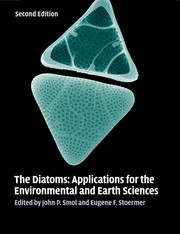Book contents
- Frontmatter
- Contents
- List of contributors
- Preface
- Part I Introduction
- Part II Diatoms as indicators of environmental change in flowing waters and lakes
- Part III Diatoms as indicators in Arctic, Antarctic, and alpine lacustrine environments
- Part IV Diatoms as indicators in marine and estuarine environments
- 15 Diatoms and environmental change in large brackish-water ecosystems
- 16 Applied diatom studies in estuaries and shallow coastal environments
- 17 Estuarine paleoenvironmental reconstructions using diatoms
- 18 Diatoms on coral reefs and in tropical marine lakes
- 19 Diatoms as indicators of former sea levels, earthquakes, tsunamis, and hurricanes
- 20 Marine diatoms as indicators of modern changes in oceanographic conditions
- 21 Holocene marine diatom records of environmental change
- 22 Diatoms as indicators of paleoceanographic events
- 23 Reconsidering the meaning of biogenic silica accumulation rates in the glacial Southern Ocean
- Part V Other applications
- Part VI Conclusions
- Glossary, acronyms, and abbreviations
- Index
- References
17 - Estuarine paleoenvironmental reconstructions using diatoms
from Part IV - Diatoms as indicators in marine and estuarine environments
Published online by Cambridge University Press: 05 June 2012
- Frontmatter
- Contents
- List of contributors
- Preface
- Part I Introduction
- Part II Diatoms as indicators of environmental change in flowing waters and lakes
- Part III Diatoms as indicators in Arctic, Antarctic, and alpine lacustrine environments
- Part IV Diatoms as indicators in marine and estuarine environments
- 15 Diatoms and environmental change in large brackish-water ecosystems
- 16 Applied diatom studies in estuaries and shallow coastal environments
- 17 Estuarine paleoenvironmental reconstructions using diatoms
- 18 Diatoms on coral reefs and in tropical marine lakes
- 19 Diatoms as indicators of former sea levels, earthquakes, tsunamis, and hurricanes
- 20 Marine diatoms as indicators of modern changes in oceanographic conditions
- 21 Holocene marine diatom records of environmental change
- 22 Diatoms as indicators of paleoceanographic events
- 23 Reconsidering the meaning of biogenic silica accumulation rates in the glacial Southern Ocean
- Part V Other applications
- Part VI Conclusions
- Glossary, acronyms, and abbreviations
- Index
- References
Summary
Introduction
Paleoecology offers powerful techniques with which to study historical changes due to human influences in depositional environments, including estuaries and coastal wetlands. Diatoms are particularly useful in these endeavors, not only because they are preserved in the sediment record, but because they have a short reproductive rate and respond quickly to changes in nutrient availability and water-quality conditions. Diatoms are abundant in aquatic environments, generally cosmopolitan in distribution, and have a fairly well-studied taxonomy and ecology.
Paleoecological studies in estuarine and coastal environments have lagged behind paleolimnology, primarily because of the more dynamic nature and presumed invulnerability of coastal ecosystems. Estuaries are characterized by variability in salinity, sediment deposition, water currents and residence time, turbidity zones, and unique biogeochemistry of sediments. There is often mixture and transport of sediments after initial deposition, and differential silicification and preservation of diatom valves.
Historically, there has been a lack of appreciation for the magnitude and severity of human impacts on estuaries and other coastal ecosystems, and of how important these ecosystems are to human society. The demand for resources and the wastes generated as human populations grow will continue to cause cultural, economic, aesthetic, and environmental problems in coastal areas. Understanding the processes surrounding these problems is important for managing the continuing impacts of growing populations (see Costanza et al., 1997; Clark et al., 2001; Niemi et al., 2004).
- Type
- Chapter
- Information
- The DiatomsApplications for the Environmental and Earth Sciences, pp. 324 - 345Publisher: Cambridge University PressPrint publication year: 2010
References
- 12
- Cited by

